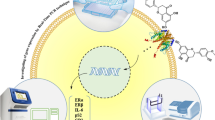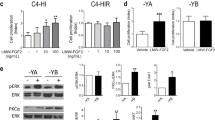Abstract
Steroid hormones and their nuclear receptors play a major role in the development and progression of breast cancer. MCF-7 cells are triple-positive breast cancer cells expressing estrogen receptor (ER), progesterone receptor (PR), and glucocorticoid receptor (GR). However, interaction and their role in expression pattern of activator protein (AP-1) transcription factors (TFs) are not completely understood. Hence, in our study, MCF-7 cells were used as an in vitro model system to study the interplay between the receptors and hormones. MCF-7 cells were treated with estradiol-17β (E2), progesterone (P4), and dexamethasone (Dex), alone or in combination, to study the proliferation of cells and expression of AP-1 genes. MTT assay results show that E2 or P4 induced the cell proliferation by more than 35 %, and Dex decreased the proliferation by 26 %. E2 and P4 are found to increase ERα by more than twofold and c-Jun, c-Fos, and Fra-1 AP-1 TFs by more than 1.7-fold, while Dex shows opposite effect of E2- or P4-induced effect as well as effect on the expression of nuclear receptors and AP-1 factors. E2 antagonist Fulvestrant (ICI 182,780) found to reduce proliferation and E2-induced expression of AP1-TFs, while P4 or Dex antagonist Mifepristone (RU486) is found to block GR-mediated expression of NRs and AP-1 mRNAs. Results suggest that E2 and P4 act synergistically, and Dex acts as an antagonist of E2 and P4.





Similar content being viewed by others
References
Brisken C, O’Malley B (2010) Hormone action in the mammary gland. Cold Spring Harb Perspect Biol 2:a003178. doi:10.1101/cshperspect.a003178
Humphreys RC, Lydon J, O’Malley BW, Rosen JM (1997) Mammary gland development is mediated by both stromal and epithelial progesterone receptors. Mol Endocrinol 11:801–811. doi:10.1210/mend.11.6.9891
Contrò V, Basile JR, Proia P (2015) Sex steroid hormone receptors, their ligands, and nuclear and non-nuclear pathways. AIMS Mol Sci 2:294–310. doi:10.3934/molsci.2015.3.294
Simoncini T, Genazzani AR (2003) Non-genomic actions of sex steroid hormones. Eur J Endocrinol 148:281–292
Clarke CL, Sutherland RL (1990) Progestin regulation of cellular proliferation. Endocr Rev 11:266–301. doi:10.1210/edrv-11-2-266
Vesely PW, Staber PB, Hoefler G, Kenner L (2009) Translational regulation mechanisms of AP-1 proteins. Mutat Res 682:7–12. doi:10.1016/j.mrrev.2009.01.001
Bjornstrom L, Sjoberg M (2005) Mechanisms of estrogen receptor signaling: convergence of genomic and nongenomic actions on target genes. Mol Endocrinol 19:833–842. doi:10.1210/me.2004-0486
Karmakar S, Jin Y, Nagaich AK (2013) Interaction of glucocorticoid receptor (GR) with estrogen receptor (ER) alpha and activator protein 1 (AP1) in dexamethasone-mediated interference of ERalpha activity. J Biol Chem 288:24020–24034. doi:10.1074/jbc.M113.473819
Uht RM, Anderson CM, Webb P, Kushner PJ (1997) Transcriptional activities of estrogen and glucocorticoid receptors are functionally integrated at the AP-1 response element. Endocrinology 138:2900–2908. doi:10.1210/endo.138.7.5244
Leo JC, Guo C, Woon CT, Aw SE, Lin VC (2004) Glucocorticoid and mineralocorticoid cross-talk with progesterone receptor to induce focal adhesion and growth inhibition in breast cancer cells. Endocrinology 145:1314–1321. doi:10.1210/en.2003-0732
Wakeling AE, Bowler J (1987) Steroidal pure antioestrogens. J Endocrinol 112:R7–R10
Osborne CK, Wakeling A, Nicholson RI (2004) Fulvestrant: an oestrogen receptor antagonist with a novel mechanism of action. Br J Cancer 90(Suppl 1):S2–S6. doi:10.1038/sj.bjc.6601629
Sharma SC, Purohit P, Rao AJ (1993) Role of oestradiol-17β in the regulation of synthesis and secretion of human chorionic gonadotrophin by first trimester human placenta. J Mol Endocrinol 11:91–101
Babu RL, Naveen Kumar M, Patil RH, Devaraju KS, Ramesh GT, Sharma SC (2013) Effect of estrogen and tamoxifen on the expression pattern of AP-1 factors in MCF-7 cells: role of c-Jun, c-Fos, and Fra-1 in cell cycle regulation. Mol Cell Biochem 380:143–151. doi:10.1007/s11010-013-1667-x
Patil RH, Babu RL, Naveen Kumar M, Kiran Kumar KM, Hegde SM, Ramesh GT, Chidananda Sharma S (2015) Apigenin inhibits PMA-induced expression of pro-inflammatory cytokines and AP-1 factors in A549 cells. Mol Cell Biochem 403:95–106. doi:10.1007/s11010-015-2340-3
Periyakaruppan A, Kumar F, Sarkar S, Sharma CS, Ramesh GT (2007) Uranium induces oxidative stress in lung epithelial cells. Arch Toxicol 81:389–395. doi:10.1007/s00204-006-0167-0
Sharma SC, Clemens JW, Pisarska MD, Richards JS (1999) Expression and function of estrogen receptor subtypes in granulosa cells: regulation by estradiol and forskolin. Endocrinology 140:4320–4334. doi:10.1210/endo.140.9.6965
Bradford MM (1976) A rapid and sensitive method for the quantitation of microgram quantities of protein utilizing the principle of protein-dye binding. Anal Biochem 72:248–254
Cunha GR, Hom YK (1996) Role of mesenchymal-epithelial interactions in mammary gland development. J Mammary Gland Biol Neoplasia 1:21–35
Tan H, Zhong Y, Pan Z (2009) Autocrine regulation of cell proliferation by estrogen receptor-alpha in estrogen receptor-alpha-positive breast cancer cell lines. BMC Cancer 9:31. doi:10.1186/1471-2407-9-31
Buxant F, Engohan-Aloghe C, Noel JC (2010) Estrogen receptor, progesterone receptor, and glucocorticoid receptor expression in normal breast tissue, breast in situ carcinoma, and invasive breast cancer. Appl Immunohistochem Mol Morphol 18:254–257. doi:10.1097/PAI.0b013e3181c10180
Pan D, Kocherginsky M, Conzen SD (2011) Activation of the glucocorticoid receptor is associated with poor prognosis in estrogen receptor-negative breast cancer. Cancer Res 71:6360–6370. doi:10.1158/0008-5472.can-11-0362
Bolt MJ, Stossi F, Newberg JY, Orjalo A, Johansson HE, Mancini MA (2013) Coactivators enable glucocorticoid receptor recruitment to fine-tune estrogen receptor transcriptional responses. Nucleic Acids Res 41:4036–4048. doi:10.1093/nar/gkt100
Guo CM, Zhu XO, Ni XT, Yang Z, Myatt L, Sun K (2009) Expression of progesterone receptor A form and its role in the interaction of progesterone with cortisol on cyclooxygenase-2 expression in amnionic fibroblasts. J Clin Endocrinol Metab 94:5085–5092. doi:10.1210/jc.2009-0832
Ponta H, Cato AC, Herrlich P (1992) Interference of pathway specific transcription factors. Biochim Biophys Acta 1129:255–261
Ross-Innes CS, Stark R, Holmes KA, Schmidt D, Spyrou C, Russell R, Massie CE, Vowler SL, Eldridge M, Carroll JS (2010) Cooperative interaction between retinoic acid receptor-alpha and estrogen receptor in breast cancer. Genes Dev 24:171–182. doi:10.1101/gad.552910
Hua S, Kittler R, White KP (2009) Genomic antagonism between retinoic acid and estrogen signaling in breast cancer. Cell 137:1259–1271. doi:10.1016/j.cell.2009.04.043
Need EF, Selth LA, Trotta AP, Leach DA, Giorgio L, O’Loughlin MA, Smith E, Gill PG, Ingman WV, Graham JD, Buchanan G (2015) The unique transcriptional response produced by concurrent estrogen and progesterone treatment in breast cancer cells results in upregulation of growth factor pathways and switching from a Luminal A to a Basal-like subtype. BMC Cancer 15:791. doi:10.1186/s12885-015-1819-3
Buxant F, Kindt N, Laurent G, Noel JC, Saussez S (2015) Antiproliferative effect of dexamethasone in the MCF-7 breast cancer cell line. Mol Med Rep 12:4051–4054. doi:10.3892/mmr.2015.3920
Zhou F, Bouillard B, Pharaboz-Joly MO, Andre J (1989) Non-classical antiestrogenic actions of dexamethasone in variant MCF-7 human breast cancer cells in culture. Mol Cell Endocrinol 66:189–197
Krishnan AV, Swami S, Feldman D (2001) Estradiol inhibits glucocorticoid receptor expression and induces glucocorticoid resistance in MCF-7 human breast cancer cells. J Steroid Biochem Mol Biol 77:29–37
Gong H, Jarzynka MJ, Cole TJ, Lee JH, Wada T, Zhang B, Gao J, Song WC, DeFranco DB, Cheng SY, Xie W (2008) Glucocorticoids antagonize estrogens by glucocorticoid receptor-mediated activation of estrogen sulfotransferase. Cancer Res 68:7386–7393. doi:10.1158/0008-5472.can-08-1545
Gundisch S, Boeckeler E, Behrends U, Amtmann E, Ehrhardt H, Jeremias I (2012) Glucocorticoids augment survival and proliferation of tumor cells. Anticancer Res 32:4251–4261
Cui X, Schiff R, Arpino G, Osborne CK, Lee AV (2005) Biology of progesterone receptor loss in breast cancer and its implications for endocrine therapy. J Clin Oncol 23:7721–7735. doi:10.1200/jco.2005.09.004
Fisher B, Wickerham DL, Brown A, Redmond CK (1983) Breast cancer estrogen and progesterone receptor values: their distribution, degree of concordance, and relation to number of positive axillary nodes. J Clin Oncol 1:349–358
Horwitz KB, Mockus MB, Lessey BA (1982) Variant T47D human breast cancer cells with high progesterone-receptor levels despite estrogen and antiestrogen resistance. Cell 28:633–642
Daniel AR, Gaviglio AL, Knutson TP, Ostrander JH, D’Assoro AB, Ravindranathan P, Peng Y, Raj GV, Yee D, Lange CA (2015) Progesterone receptor-B enhances estrogen responsiveness of breast cancer cells via scaffolding PELP1- and estrogen receptor-containing transcription complexes. Oncogene 34:506–515. doi:10.1038/onc.2013.579
Daniel AR, Gaviglio AL, Knutson TP, Ostrander JH, Yee D, Lange CA (2013) Unliganded progesterone receptors augment estrogen-induced growth of breast cancer cells via co-regulation of estrogen receptor target genes. Cancer Res 73:3572–3578
Amsterdam A, Tajima K, Sasson R (2002) Cell-specific regulation of apoptosis by glucocorticoids: implication to their anti-inflammatory action. Biochem Pharmacol 64:843–850
Lippman M, Bolan G, Huff K (1976) The effects of glucocorticoids and progesterone on hormone-responsive human breast cancer in long-term tissue culture. Cancer Res 36:4602–4609
Acknowledgments
The authors wish to express their gratitude to the Department of Science and Technology-Promotion of University Research and Scientific Excellence (DST-PURSE) [SR/59/Z-23/2010/38(c)] and University Grant Commission Centre with Potential for Excellence in Particular Area (UGC-CPEPA) [8-2/2008(NS/PE)], New Delhi for providing financial support. The authors also wish to express their gratitude to the Department of Microbiology and Biotechnology, Bangalore University, Bengaluru for providing the DST-FIST, UGC-SAP, and department facility.
Author information
Authors and Affiliations
Corresponding author
Rights and permissions
About this article
Cite this article
Hegde, S.M., Kumar, M.N., Kavya, K. et al. Interplay of nuclear receptors (ER, PR, and GR) and their steroid hormones in MCF-7 cells. Mol Cell Biochem 422, 109–120 (2016). https://doi.org/10.1007/s11010-016-2810-2
Received:
Accepted:
Published:
Issue Date:
DOI: https://doi.org/10.1007/s11010-016-2810-2




